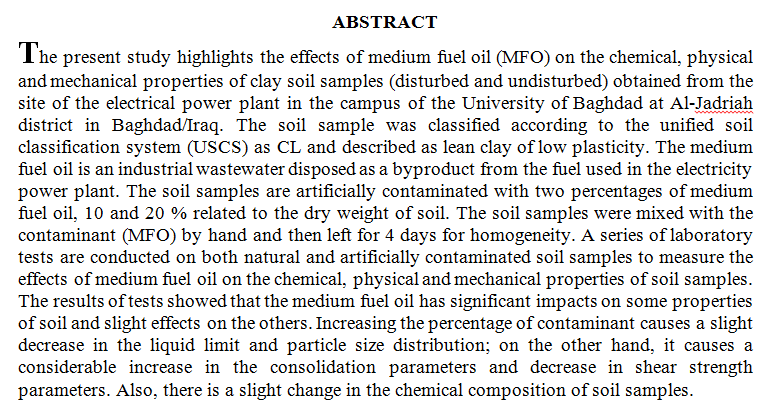
Tensile , thermal, and barrier properties of polylactide PLA-based
nanocomposite films that were prepared by solvent casting method with
polyethylene glycol (PEG), and alumina were studied. PLA/PEG blend showed
decrease in tensile strength and Young modulus but increased in elongation in
PLA/PEG and increased in crystalline of PLA but decrease in glass transition
temperature with the increasing of PEG concentration . A nano blend composites of
PLA/PEG/alumina (50/50/4) when compared to PLA/PEG blend indicated that
tensile strength , Young modulus and glass transition temperature (Tg) increased
with adding alumina nano particles, concentration and barrier properties
improvement due to its nucleating and reinforc
 (1)
(1)
In this research a study of some electrical properties Of (Te) thin films with(S) impurities of(1.2%) were deposited at( Ө=700)by thermal evaporation technique .The thicknesses of deposited films were (1050 , 1225 , 1400 , 1575 nm) on a glass substrates of different dimensions . From X-ray diffraction spectrum, the films are polycrystalline .A study of (I-V) characteristic for thin films, the measurements of electrical conductivity (σ)and electrical resistance(R )vs. temperature( T) are done. Further a measurement of thermoelectric power, see beck coefficient and activation energies ( Ea, Es) were computed
 (5)
(5)
 (5)
(5)
 (23)
(23)
 (12)
(12)
The two-dimensional transient heat conduction through a thermal insulation of temperature dependent thermal properties is investigated numerically using the FVM. It is assumed that this insulating material is initially at a uniform temperature. Then, it is suddenly subjected at its inner surface with a step change in temperature and subjected at its outer surface with a natural convection boundary condition associated with a periodic change in ambient temperature and heat flux of solar radiation. Two thermal insulation materials were selected. The fully implicit time scheme is selected to represent the time discretization. The arithmetic mean thermal conductivity is chosen to be the value of the approximated thermal conductivity at the i
... Show MoreAzo-Schiff base compounds (L1 and L2) have been synthesized from the reaction of m-hydroxy benzoic acid with 1,5-dimethyl-3-[2-(5-methyl-1H-indol-3-yl)-ethylimino]-2-phenyl-2,3- dihydro-1H-pyrazol-4-ylamine and with 3-[2-(1H-indol-3-yl)-ethylimino]-1,5-dimethyl-2-phenyl- 2,3-dihydro-1H-pyrazol-4-ylamine. The free ligands and their complexes were characterized based on elemental analysis, determination of metal, molar conductivity, (1H, 13C) NMR, UV–vis, FT-IR, mass spectra and thermal analysis (TGA). The molar conductance data revealed that all the complexes are non-electrolytes. The study of complex formation via molar ratio in DMF solution has been investigated and results were consistent to those found in the solid complexes with a rat
... Show More (41)
(41)
 (30)
(30)
Nanoparticles of Pb1-xCdxS within the composition of 0≤x≤1 were prepared from the reaction of aqueous solution of cadmium acetate, lead acetate, thiourea, and NaOH by chemical co-precipitation. The prepared samples were characterized by UV-Vis spectroscopy(in the range 300-1100nm) to study the optical properties, AFM and SEM to check the surface morphology(Roughness average and shape) and the particle size. XRD technique was used to determine the crystalline structure, XRD technique was used to determine the purity of the phase and the crystalline structure, The crystalline size average of the nanoparticles have been found to be 20.7, 15.48, 11.9, 11.8, and 13.65 nm for PbS, Pb0.75Cd0.25S,
... Show More (17)
(17)
 (6)
(6)
